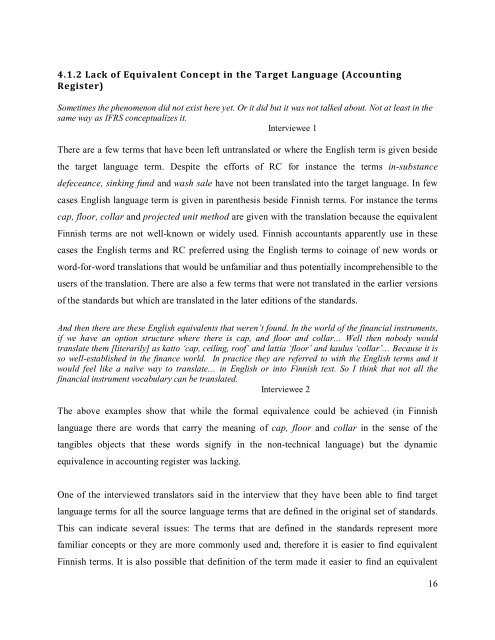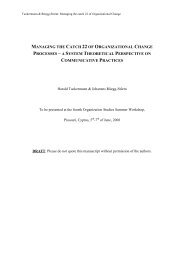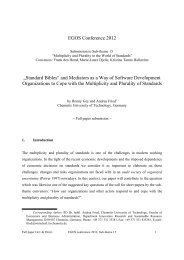A single set of standards and the multiplicity of interpretations - EGOS
A single set of standards and the multiplicity of interpretations - EGOS
A single set of standards and the multiplicity of interpretations - EGOS
You also want an ePaper? Increase the reach of your titles
YUMPU automatically turns print PDFs into web optimized ePapers that Google loves.
4.1.2 Lack <strong>of</strong> Equivalent Concept in <strong>the</strong> Target Language (Accounting<br />
Register)<br />
Sometimes <strong>the</strong> phenomenon did not exist here yet. Or it did but it was not talked about. Not at least in <strong>the</strong><br />
same way as IFRS conceptualizes it.<br />
Interviewee 1<br />
There are a few terms that have been left untranslated or where <strong>the</strong> English term is given beside<br />
<strong>the</strong> target language term. Despite <strong>the</strong> efforts <strong>of</strong> RC for instance <strong>the</strong> terms in-substance<br />
defeceance, sinking fund <strong>and</strong> wash sale have not been translated into <strong>the</strong> target language. In few<br />
cases English language term is given in paren<strong>the</strong>sis beside Finnish terms. For instance <strong>the</strong> terms<br />
cap, floor, collar <strong>and</strong> projected unit method are given with <strong>the</strong> translation because <strong>the</strong> equivalent<br />
Finnish terms are not well-known or widely used. Finnish accountants apparently use in <strong>the</strong>se<br />
cases <strong>the</strong> English terms <strong>and</strong> RC preferred using <strong>the</strong> English terms to coinage <strong>of</strong> new words or<br />
word-for-word translations that would be unfamiliar <strong>and</strong> thus potentially incomprehensible to <strong>the</strong><br />
users <strong>of</strong> <strong>the</strong> translation. There are also a few terms that were not translated in <strong>the</strong> earlier versions<br />
<strong>of</strong> <strong>the</strong> <strong>st<strong>and</strong>ards</strong> but which are translated in <strong>the</strong> later editions <strong>of</strong> <strong>the</strong> <strong>st<strong>and</strong>ards</strong>.<br />
And <strong>the</strong>n <strong>the</strong>re are <strong>the</strong>se English equivalents that weren’t found. In <strong>the</strong> world <strong>of</strong> <strong>the</strong> financial instruments,<br />
if we have an option structure where <strong>the</strong>re is cap, <strong>and</strong> floor <strong>and</strong> collar… Well <strong>the</strong>n nobody would<br />
translate <strong>the</strong>m [literarily] as katto ‘cap, ceiling, ro<strong>of</strong>’ <strong>and</strong> lattia ‘floor’ <strong>and</strong> kaulus ‘collar’… Because it is<br />
so well-established in <strong>the</strong> finance world. In practice <strong>the</strong>y are referred to with <strong>the</strong> English terms <strong>and</strong> it<br />
would feel like a naïve way to translate… in English or into Finnish text. So I think that not all <strong>the</strong><br />
financial instrument vocabulary can be translated.<br />
Interviewee 2<br />
The above examples show that while <strong>the</strong> formal equivalence could be achieved (in Finnish<br />
language <strong>the</strong>re are words that carry <strong>the</strong> meaning <strong>of</strong> cap, floor <strong>and</strong> collar in <strong>the</strong> sense <strong>of</strong> <strong>the</strong><br />
tangibles objects that <strong>the</strong>se words signify in <strong>the</strong> non-technical language) but <strong>the</strong> dynamic<br />
equivalence in accounting register was lacking.<br />
One <strong>of</strong> <strong>the</strong> interviewed translators said in <strong>the</strong> interview that <strong>the</strong>y have been able to find target<br />
language terms for all <strong>the</strong> source language terms that are defined in <strong>the</strong> original <strong>set</strong> <strong>of</strong> <strong>st<strong>and</strong>ards</strong>.<br />
This can indicate several issues: The terms that are defined in <strong>the</strong> <strong>st<strong>and</strong>ards</strong> represent more<br />
familiar concepts or <strong>the</strong>y are more commonly used <strong>and</strong>, <strong>the</strong>refore it is easier to find equivalent<br />
Finnish terms. It is also possible that definition <strong>of</strong> <strong>the</strong> term made it easier to find an equivalent<br />
16









